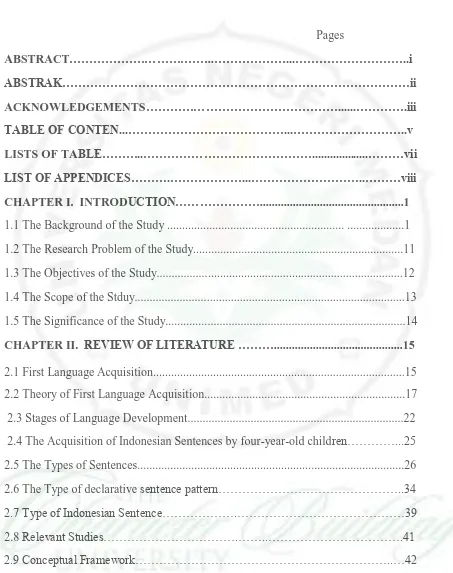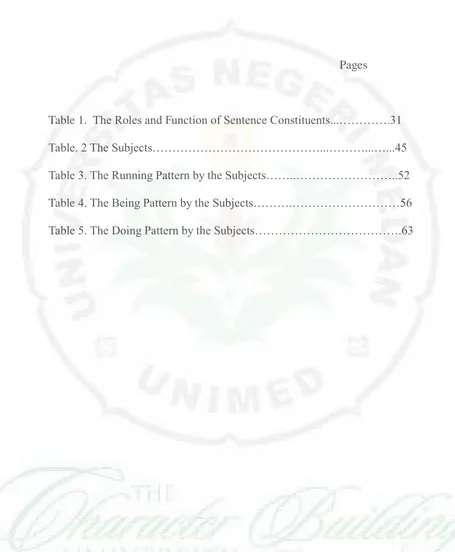THE ACQUISITION OF INDONESIAN DECLARATIVE SENTENCE
BY THE FOUR-YEAR- OLD CHILDREN
A Thesis
Submitted to the English Applied Linguistics Study Program in Partial Fulfillment of the Requirements for the Degree of Magister Humaniora
By:
SARNI ERNAWATY PURBA Registration Number : 8126112032
ENGLISH APPLIED LINGUISTICS STUDY PROGRAM
POSTGRADUATE SCHOOL
STATE UNIVERSITY OF MEDAN
ABSTRACT
Purba, Sarni Ernawaty . The Acquisition of Indonesian Declarative Sentence by Four-Year-Old Children. Thesis English Applied Linguistics, Post Graduate Program. State University of Medan. 2014
ABSTRAK
Purba, Sarni Ernawaty. Nim: 8126112032. Perolehan Kalimat Deklaratif Bahasa Indonesia oleh Anak Pada Usia Empat Tahun. Tesis. Linguistik Terapan Bahasa Inggris, Programsarjana. Universitas Negeri Medan. 2014
ACKNOWLEDGEMENTS
First of all, the researcher would like to express her thankfulness to God the
Almighty who has been blessing her to complete this thesis in order to fulfill one of the
requirements in obtaining the degree of Magister Humaniora of the English Applied
Linguistics Study Program Graduate School at State University of Medan. The researcher
found many difficulties during her study and in completing this study. However, people
around her always give her help so difficulties could be solved. Therefore, she wishes to
acknowledge her very special thanks to her first and second advisors, Dr. Anni Holila
Pulungan, M.Hum. and Dr. I Wayan Dirgayasa Tangkas, M.Hum., for their valuable
guidance, encouragement, kindness and advice to broaden her perception and knowledge
on this topic.
Her gratitude also goes to the Head of English applied Linguistics Study Program
and as her review Prof. Dr. Busmin Gurning, M.Pd, for his support, advice and help
during her study and in completing this study. Her great gratitude is also due to her
reviewers Dr. Sri Minda Murni, M.S. and Dr. Siti Aisyah Ginting, M. Pd. For their
constructive comments and suggestions for this research. Her sincere thankfulness is given
to all lecturers for their precious knowledge , experiences, advice and guidance thoughout
her academic years at the Post Graduate School of State University of Medan. Aslo deep
gratitude to all staff of Graduate Program at the State University of Medan.
She is also indebted to all my classmates Bang Pollung, Kak Trisna, Yulima, Wina,
Desi, Nurhalima, Wandira, Irma, Rina, Purnama, Rodiani, Bambang, Zulmi, Zamal, Mas
Agung, Rianto, Indra, Ayu, Chitra, Elbi and Deddy for their loving care.
Finally, she would like to express her sincere thankfulness to her mother and her sisters
very special one, her small family, especially for her Husband, Anggiat Sept Parulian
Sihombing and her loving sons, Rema Daud Tua, Rena Patiencius Hiram and Rexa
Hotiggo Blessing for their loving care, prayer, support, and encouragement.
Medan, December 2014
The writer
TABLE OF CONTENTS
CHAPTER I. INTRODUCTION………...1
1.1 The Background of the Study ... ...1
1.2 The Research Problem of the Study...11
1.3 The Objectives of the Study...12
1.4 The Scope of the Stduy...13
1.5 The Significance of the Study...14
CHAPTER II. REVIEW OF LITERATURE ………...15
2.1First Language Acquisition...15
2.2 Theory of First Language Acquisition...17
2.3 Stages of Language Development...22
2.4 The Acquisition of Indonesian Sentences by four-year-old children…………...25
2.5 The Types of Sentences...26
2.6 The Type of declarative sentence pattern………..34
2.7 Type of Indonesian Sentence……….………39
2.8 Relevant Studies……….……..……….41
2.9 Conceptual Framework………..…42
CHAPTER III. METHOD OF RESEARCH……….44
3.1 The Research Design...44
3.3 The Technique of Collecting Data……….………...46
3.4 The Instrument of collecting Data……….47
3.5 The Trustworthiness ……….….………...47
3.6 The Technique of Analyzing the data………49
CHAPTER IV. DATA ANALYSIS AND FINDINGS….………...51
4.1 The Data Analysis………..52
4.2 Findings………66
4.3 Discussion………..………66
CHAPTER V. CONCLUSIONS AND SUGGESTIONS……….71
5.1 Conclusions ………..……….71
5.2 Suggestions………71
References………73
Lists of Table
Pages
Table 1. The Roles and Function of Sentence Constituents...………….31
Table. 2 The Subjects………...………...…...45
Table 3. The Running Pattern by the Subjects……..………..52
Table 4. The Being Pattern by the Subjects……….………56
List of Appendices
71
CHAPTER V
CONCLUSION AND SUGGESTION
5.1 Conclusion
From the data and data analysis in chapter four is concluded that :
1. There are 40 Indonesian Declarative Sentences produced by the two subjects.
Michael Wisnu produced 6 running pattern which has sub-patterns S-P-Adv, P-S,
Adv-S-P, P-S-Adv, S-P-Adv and Adv-S-P, 9 being pattern which has sub-patterns
S-P and S, 5 doing/seeing patterns which has sub-patterns O-Adv-S, S-O,
P-O-Adv-S, Adv-S-P-O-Adv and S-P. However, Rexa H. Blessing produced 4
running pattern which has sub-patterns P-S, Adv-Adv-S-P, P-S, and P, 12 being
patterns which has sub-patterns S-P, Adv-Adv-P-S, Adv-S-P, P-S and P, 4
doing/seeing patterns which has sub-patterns S-Adv-P-O, S-P-O, O-S-P, O-S-P and
Adv-P-O.
2. The subjects produced the being pattern and sub-pattern S-P dominantly.
3. The subjects were basically influenced both ‘nature’ and ‘nurture’ process in
producing their sentences. It is also true that differences across the languages are
not only differences between children. There are also individual differences
between children producing the same language. Each sentence of the two subjects
has its own characteristic.
72
After the conclusion of the acquisition of Indonesian declarative sentence by
four-year children was made, the researcher would suggest to parents and
researchers.
1. To the parent
The parents assist the children in the process of language acquisition. Parents
allow them to communicate freely to produce sentences in different situation
and there should be someone to converse with them in order to acquire many
kinds of words they have heard because children produce sentences based on
what they hear. The parents should be creative helping the children in the
process of acquiring their sentences. Parents encourage the children to
communicate and produce the correct sentences and if they make mistakes, give
the exact one.
2.To other researchers
This is suggested that there will be some further research about this study,
particularly, it will be deal with the acquisition of declarative sentence by
children with large number of subject. Perhaps, there will be so many things
different. Additional, another research done is to get better understanding of this
73
REFERENCES
Carter, R. and McCarty, M. 2006. Cambridge Grammar of English. New York: Cambridge University Press.
Chaer, A. 2006.Tata Bahasa Praktis Bahasa Indonesia. Jakarta. PT. Rineka Cipta.
Cheng, L. Sybesma, R. 1999. “Bare and not-so-bare nouns and structure of NP” Linguistic Inquiry 30: pp. 509-542
Chierchia, G. 1998. “Reference to kinds across languages”. Natural Language Semantics 6: 339-405
Chomsky, N. 1975. Reflections on Languages. New York: Pantheon.
Clark, E. V 1981. Lectures on governmental and binding: the Pisa Lecturer. Dordrecht: Foris.
Clark, E. 2003.First Language Acquisition. United Kingdom: Cambridge University Press.
Clark, E. V. 1981. Negatives verbs in Children’s speech. In W. Klein & W. J M. Levelt (Eds), Crossing the boundaries in linguistics. Dordrechrt; Reidel.
Borden, M. E. 2001. Smart Start: Panduan Lengkap Memilih Pendidikan Prasekolah
Dutwin, P . 2010 English Grammar Demystified. New York: McGraw-Hill.
Finoza, L. 2010. Komposisi Bahasa Indonesia. Jakarta. Bandy & Andy
Finney, M. A. 2005 Perception of Errors in Second Language Syntax: Acqusition or Processing Difficulties. Proceedings of the 4th International Symposium on Bilingualism, Somerville 2005
74
Gleason, Jean Berko and Ratner. Nan Berstein. 1998. Language Acquisition: in Gleason, Jean Berko and Ratner. Nan Berstein (Eds). Psycholinguistic. Forth Worth: Harcourt Brace College
Goode, W. & Hustt P. K. 1982.Methods in Social Research. New York: McGraw Hill.
Goodluck, H. 1991. Language Acquisition: A Linguistic Introduction. UK Blackwell
Greenbaum, S. & Gerlad. N. 2002. An Introduction to English Grammar. United Kingdom: Pearson Education
Guasti, M. T. 2002 Language Acquisition: The Growth of Grammar. Massachusetts: The MIT Press.
Hoff, G. E. 2003 Mother-child conversation in different social class and communicative setting-Child Development, 62 (4) 782--96
Hutterlocher, J., Vasilyeva, M., & Shimpi, P. (2004) Syntactic priming in young children. Journal of Memory and Language, 50. 182-195
Hyams, N. 1986. Language acquisition and the theory of parameters. Dordrech: Reidel.
Ingram, D. 1989. First language Acquisition: Method, Description, and Explanation. New York: Cambridge University Press.
Jackson, Howard. And Ze Amvela, Etienne. 2000. Words, Meaning and Vocabulary. An Introduction to Modern Lexicology. Great Britain: Cromwell Press.
Kroger, P. R. 2005. Analyzing Grammar: An Introduction. New York: Cambridge University Press. Paivio, A and Begg, I. 1981.Psychology of Language. New Jersey: Prentice Hall.
Keraf, G. 1984. Tata Bahasa Indonesia. Flores: Penerbit Nusa Indah
Krashen, S.D. 1982. Principles and Practice in Second Language Acquisition. Oxford: Pergamon.
Krashen, S.D. 1985. The Input Hypothesis: Issues and Implications, New York: Longman
Krashen, S.D. 1989. "We Acquire Vocabulary and Spelling by Reading: Additional Evidence for the Input Hypothesis", The Modern Language Journal 73 (4), pp. 440–464
75
Krashen, S.D. 1996. The case for narrow listening 24 (1), System, pp. 97–100
Malau, L. 2011. The Acqusition of Indonesian Words by Four-Year-Old Batak Toba Children. Unpublished. State University of Medan. (Thesis)
Marshall, Chaterine & Gretchen B. Rossman. 1995. Designing Qualitative Research. London:Sage
Miles, Matthew B. and Huberman Michael A. 1984. Qualitative Data Analysis. A Sourcebook of New Methods. California: Sage Publication
O‟Grady, W. (2005). Syntactic capentary: An emergentist approach to syntax. Mahwah, NJ: Lawerence Erlbaum Associates
Paivio, A and Begg, I. 1981.Psychology of Language. New Jersey: Prentice Hall. Inc
Piattelli, M and Palmarini. 1980. Language and Debate: The Debate Jean
Piaget and Noam Chomsky pp. 25-52, 57-61. Cambridge: Harvard University Press
Pulungan, A. H. 2003. The Acquisition of English Negation „No‟ and „Not‟: Evidences from an Indonesian child in Non-native Parents Bilingual Program. Puslit. Jurusan Sastra Inggris, Fakultas Sastra, Universitas Kristen Petra, vol. 5, No. 1, 41-48
Radford, A. 2009. An Introduction: English Sentence Structure. New York: Cambridge University Press.
Rah, A. 2010. Transfer in L3 Sentence Processing: Evidence from Relative Clause Attachement Ambiguities. International Journal of Multilingualism, Vol 19, No. 7, 147-161
Rowland, C. 2014. Understanding Child Language. Great Britain: CPI Group (UK)
Seliger, H. W., and Shohamy, E,. 1989. Second language Research Methods. London: Oxford University Press.
Sinaga, J. E. 2010. The Acqusition of English Words by Hokkean Children: A Case Study at Prime One School. Unpublished. State University of Medan. (Thesis)
Smith, Linda, & Yu, Chen (2008): „Infants rapidly learn word-referent mappings via cross-situational statistics‟. Cognition, 106, 1558-1568. Yokyakarta: Duta WacanaUniversity Press
Sudaryanto, 1993. Metode dan Aneka Teknik Analisis Bahasa. Yokyakarta: Duta WacanaUniversity Press
76
Wrembel, M. 2000. Accented Speech in Production. International Journal of Multilingualism, vol. 19, no 1, 59-75

